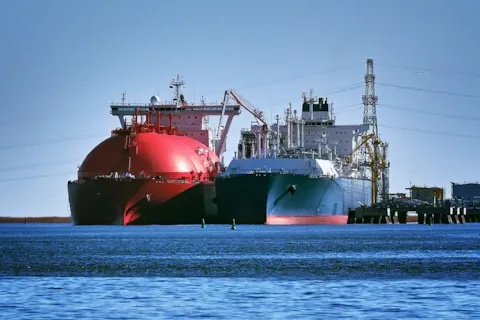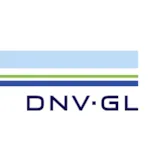Get regular gas carrier insights!
Don’t be left out. Join the many others and sign up today to receive the latest insights.
Sign up
Gas as one means of reducing greenhouse gas emissions will experience significant growth and so will gas transport and storage. DNV GL’s newly established Gas Carrier Excellence Center is working closely with the industry to foster the development of new gas technologies and support projects by applying established rules and standards.

Monika Johannessen holds an MSc in naval engineering and relies on 14 years of experience within the maritime and oil and gas industries. Monika has worked on projects related to piping and cargo handling systems and was engaged in approvals of gas carriers and as a project manager for several floating storage and regasification unit (FSRU) projects as well as floating LNG production projects. Since November 2019 Monika is heading DNV GL’s newly established Gas Carrier Excellence Center.
What is the intention in setting up a Gas Carrier Excellence Center within DNV GL – Maritime?

As forecasted in our Energy Transition Outlook reports, natural gas as an energy source will experience the highest growth in the mid and long-term future. That of course comes along with an increased demand for gas transport and technologies. To better serve the increasing needs of our customers and the gas industry we wanted to establish a setting that enables us to work more efficiently and closely with our customers. That is why we set up the Gas Carrier Excellence Center (GCEC).

What are the main tasks of the centre?

GCEC is responsible for all matters related to tankers carrying liquefied gas. That involves the continuous development and maintenance of our class rules, guidelines and instructions not only for the vessels but also for gas fuel tanks. We perform design approval of ship and machinery piping, cargo containment and cargo handling systems for all types of gas carriers, including FSRUs, in addition to approval of gas fuel tanks. We provide technical support to all relevant stakeholders, such as shipowners, sub-suppliers, yards and authorities during all stages of a gas tanker’s life cycle. That includes early phase assessment and concept evaluation to approval of newbuilding documentation and finally support to vessels in operation . Our experts are also performing assessments and approvals of novel technologies by applying DNV GL’s rule framework.

Which new concepts and technologies related to gas has DNV GL been working on in the last two years?

Our gas experts conducted concept evaluations and approvals in principle (AIP) for different projects driving forward the LNG infrastructure. This includes new cargo containment systems for LNG transportation, LNG transfer solutions and LNG floating power plants. The floating plant system is a concept designed for installation in areas where energy demand is rapidly increasing, but onshore infrastructure is not feasible or commercially viable. Instead, the LNG is offloaded from a carrier, stored on board the floating power plant in tanks, and then regasified for power generation and exported to the onshore grid. With our newly developed Alternative Survey Program for uninterrupted operations and rules for mooring systems, we are ready to tackle the challenges related to floating regasification. We have developed new rules to ensure feasible and safe application of LPG as fuel. The rules have already been applied to approve LPG vessels that will be retrofitted. After the conversion, these will be the very first gas carriers to run on LPG and will also receive the newly developed DNV GL class notation “GF LPG”.

How can customers contact the unit?

The customers now have a single point of contact within DNV GL for all issues relating to gas carriers. Our expertise will also be available through our regional offices, as we are supporting them through our position as an internal competence hub. Due to high activity within the gas segment in South-East Europe and the Middle East, a local Gas Carrier Center has been established in Piraeus to serve local market needs. This set-up allows us to work consistently and have better reach to customer needs.

What developments do you see in the gas segment and how can the GCEC support these?

With stricter emission regulations targeted by IMO, the application of gas as fuel is growing. Expanding the LNG bunkering infrastructure is further contributing to driving this development. For fuel tank technology and bunkering vessels, we also see increased activity and demand. The small-scale LNG market is on the rise and enables LNG and potentially also power to be served to smaller markets by requiring less extensive infrastructure. Initiatives to combat climate change by reducing CO2 emissions is resulting in increased interest in concepts for the transport and storage of CO2. DNV GL is providing rules and standards for this application and has already been evaluating cargo tank designs for CO2 transportation. Our experts have established a successful process of assessing technologies supporting the development of such new concepts. After a thorough assessment under consideration of known rules and standards, an AIP can be issued that the customer can use to further develop and market their system.

What are the major opportunities for the gas carrier segment in the next five years?

We predict a high demand for LNG in the world in the years to come, and we see a few upcoming megaprojects such as the North Field Expansion Project in Qatar and Mozambique LNG, which will greatly influence the gas carrier segment. For such large projects with many similar orders, we see the benefit of applying a standard process to harvest synergies and to save costs. DNV GL’s complete rules and standards for gas carriers, for example, are established and notable instruments ensuring predictable, reliable and safe processes in large projects. With respect to infrastructure, there is a lot of movement in the FSRU market. Gas used to generate electricity or feeding it into the onshore grid is an attractive option, particularly in remote areas with little or no pre-existing natural resources or import facilities.

Don’t be left out. Join the many others and sign up today to receive the latest insights.
Sign up